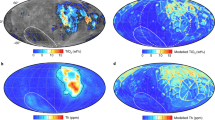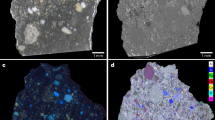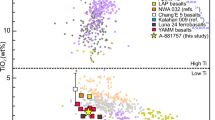Abstract
The early impact flux recorded by the Moon, especially the first billion years during the basin-forming epoch, is pivotal to understanding the evolution of inner Solar System bodies. However, our current understanding of this critical epoch is impeded by the lack of samples that have a clear provenance from specific ancient impact basins. Here we examine three impact-melt clasts in the Chang’e-6 lunar regolith collected from the Apollo basin within the gigantic South Pole–Aitken basin. We found that the impact-melt rocks, which have KREEP-like compositional signatures, probably originated from the differentiates of a South Pole–Aitken basin impact-melt sheet or pool, which were later reworked by the Apollo basin-forming event at ~4.16 Ga. This study suggests that the basin-forming epoch did not occur within the narrow timespan of ~3.8–4.0 Ga proposed for a cataclysmic late heavy bombardment.
This is a preview of subscription content, access via your institution
Access options
Access Nature and 54 other Nature Portfolio journals
Get Nature+, our best-value online-access subscription
$32.99 / 30 days
cancel any time
Subscribe to this journal
Receive 12 digital issues and online access to articles
$119.00 per year
only $9.92 per issue
Buy this article
- Purchase on SpringerLink
- Instant access to full article PDF
Prices may be subject to local taxes which are calculated during checkout






Similar content being viewed by others
Data availability
The CE-6 sample involved in this work was allocated by the Chinese National Space Administration (CNSA) under a materials transfer agreement (www.cnsa.gov.cn/n6758823/n6758839/c6811124/content.html). The prepared sample mounts are presently stored at GIGCAS, and they will be returned to CNSA after a 1-year loan. Readers may request Chang’e-6 samples from CNSA through a standard procedure. All data presented in this study are available in the Article and its source data. Source data are provided with this paper.
References
Shearer, C. et al. Magmatic evolution II: a new view of post-differentiation magmatism. Rev. Mineral. Geochem. 89, 147–206 (2023).
Korotev, R. L. The great lunar hot spot and the composition and origin of the Apollo mafic (“LKFM”) impact‐melt breccias. J. Geophys. Res. Planets 105, 4317–4345 (2000).
Warren, P. H. The magma ocean concept and lunar evolution. Annu. Rev. Earth Planet. Sci. 13, 201–240 (1985).
Jolliff, B. L., Gillis, J. J., Haskin, L. A., Korotev, R. L. & Wieczorek, M. A. Major lunar crustal terranes: surface expressions and crust‐mantle origins. J. Geophys. Res. Planets 105, 4197–4216 (2000).
Zhang, N. et al. Lunar compositional asymmetry explained by mantle overturn following the South Pole–Aitken impact. Nat. Geosci. 15, 37–41 (2022).
Moriarty, D. & Pieters, C. The character of South Pole–Aitken basin: patterns of surface and subsurface composition. J. Geophys. Res. Planets 123, 729–747 (2018).
Jolliff, B. L. et al. Non-mare silicic volcanism on the lunar farside at Compton–Belkovich. Nat. Geosci. 4, 566–571 (2011).
Uemoto, K. et al. Evidence of impact melt sheet differentiation of the lunar South Pole–Aitken basin. J. Geophys. Res. Planets 122, 1672–1686 (2017).
Osinski, G. R. et al. Lunar impact features and processes. Rev. Mineral. Geochem. 89, 339–371 (2023).
Wetherill, G. Late heavy bombardment of the moon and terrestrial planets. In 6th Annual Lunar and Planetary Science Conference 1539–1561 (Lunar and Planetary Institute, 1975).
Bottke, W. F. & Norman, M. D. The late heavy bombardment. Annu. Rev. Earth Planet. Sci. 45, 619–647 (2017).
Fassett, C. I. & Minton, D. A. Impact bombardment of the terrestrial planets and the early history of the Solar System. Nat. Geosci. 6, 520–524 (2013).
Snape, J. F. et al. Post-Imbrium Pb–Pb isochron ages for Apollo basaltic impact melt samples 14078 and 68415. R. Soc. Open Sci. 11, 231963 (2024).
Orgel, C. et al. Ancient bombardment of the inner solar system: reinvestigation of the “fingerprints” of different impactor populations on the lunar surface. J. Geophys. Res. Planets 123, 748–762 (2018).
Spudis, P. D. Apollo 16 site geology and impact melts: Implications for the geologic history of the lunar highlands. J. Geophys. Res. Solid Earth 89, C95–C107 (1984).-
Warren, P. H. The Moon. In Treatise on Geochemistry 559–599 (Elsevier, 2003).
Fassett, C. et al. Lunar impact basins: stratigraphy, sequence and ages from superposed impact crater populations measured from Lunar Orbiter Laser Altimeter (LOLA) data. J. Geophys. Res. Planets 117, E00H06 (2012).
Hiesinger, H. et al. The lunar cratering chronology. Rev. Mineral. Geochem. 89, 401–451 (2023).
Qian, Y. et al. Extensive intrusive magmatism in the lunar farside Apollo and South Pole–Aitken Basins, Chang’e-6 landing site. Astrophys. J. Lett. 971, L39 (2024).
Cui, Z. et al. A sample of the Moon’s far side retrieved by Chang’e-6 contains 2.83-billion-year-old basalt. Science 368, 1395–1399 (2024).
Zhang, Q. W. et al. Lunar farside volcanism 2.8 billion years ago from Chang’e-6 basalts. Nature 643, 356–360 (2025).
Walker, D., Powell, M., Lofgren, G. E. & Hays, J. Dynamic crystallization of a eucrite basalt. In 9th Annual Lunar and Planetary Science Conference 1369–1391 (Lunar and Planetary Institute, 1978).
Jolliff, B., Floss, C., McCallum, I. & Schwartz, J. Geochemistry, petrology, and cooling history of 14161, 7373: a plutonic lunar sample with textural evidence of granitic-fraction separation by silicate-liquid immiscibility. Am. Miner. 84, 821–837 (1999).
Takeda, H., Mori, H., Ishii, T. & Miyamoto, M. Thermal and impact histories of pyroxenes in lunar eucrite-like gabbros and eucrites. In 12th Annual Lunar and Planetary Science Conference 1297–1313 (Lunar and Planetary Institute, 1982).
Cronberger, K. & Neal, C. R. KREEP basalt petrogenesis: insights from 15434,181. Meteorit. Planet. Sci. 52, 827–841 (2017).
Fagan, T. J., Kashima, D., Wakabayashi, Y. & Suginohara, A. Case study of magmatic differentiation trends on the Moon based on lunar meteorite Northwest Africa 773 and comparison with Apollo 15 quartz monzodiorite. Geochim. Cosmochim. Acta 133, 97–127 (2014).
Neal, C. & Kramer, G. The composition of KREEP: a detailed study of KREEP basalt 15386. In 34th Annual Lunar and Planetary Science Conference 2023 (Lunar and Planetary Institute, 2003).
Reimold, W. et al. Isotope analysis of crystalline impact melt rocks from Apollo 16 stations 11 and 13, North Ray Crater. J. Geophys. Res. Solid Earth 90, C431–C448 (1985).
Moriarty, D. et al. Evidence for a stratified upper mantle preserved within the South Pole–Aitken basin. J. Geophys. Res. Planets 126, e2020JE006589 (2021).
Haskin, L. A., Korotev, R. L., Rockow, K. M. & Jolliff, B. L. The case for an Imbrium origin of the Apollo thorium‐rich impact‐melt breccias. Meteorit. Planet. Sci. 33, 959–975 (1998).
Garrick-Bethell, I. & Zuber, M. T. An indigenous origin for the South Pole Aitken basin thorium anomaly. Geophys. Res. Lett. 32, L13203 (2005).
Vaughan, W. M. & Head, J. W. Impact melt differentiation in the South Pole–Aitken basin: some observations and speculations. Planet. Space Sci. 91, 101–106 (2014).
Wang, X. et al. Lunar farside South Pole–Aitken basin interior: evidence for more extensive central cryptomaria in the South Pole–Aitken compositional anomaly (SPACA). J. Geophys. Res. Planets 129, e2023JE008176 (2024).
Joy, K. et al. Evidence of a 4.33 billion year age for the Moon’s South Pole–Aitken basin. Nat. Astron. https://doi.org/10.1038/s41550-024-02380-y (2024).
Melosh, H. et al. South Pole–Aitken basin ejecta reveal the Moon’s upper mantle. Geology 45, 1063–1066 (2017).
Zhang, Y. et al. The very late-stage crystallization of the lunar magma ocean and the composition of immiscible urKREEP. Earth Planet. Sci. Lett. 646, 118989 (2024).
Barboni, M. et al. High-precision U–Pb zircon dating identifies a major magmatic event on the Moon at 4.338 Ga. Sci. Adv. 10, eadn9871 (2024).
Su, B. et al. South Pole–Aitken massive impact 4.25 billion years ago revealed by Chang’e-6 samples. Natl Sci. Rev. 12, nwaf103 (2025).
Potter, R. W., Head, J. W., Guo, D., Liu, J. & Xiao, L. The Apollo peak-ring impact basin: Insights into the structure and evolution of the South Pole–Aitken basin. Icarus 306, 139–149 (2018).
Xu, L. et al. Chronology, local stratigraphy, and foreign ejecta materials at the Chang’e-6 landing site: constraints on the provenance of samples returned from the Moon’s farside. Geophys. Res. Lett. 51, e2024GL111311 (2024).
Ryder, C. Lunar samples, lunar accretion and the early bombardment of the Moon. Trans. Am. Geophys. Union 71, 313–323 (1990).
Neukum, G., Ivanov, B. A. & Hartmann, W. K. Cratering records in the inner Solar System in relation to the lunar reference system. Space Sci. Rev. 96, 55–86 (2001).
Nemchin, A. et al. Timing of crystallization of the lunar magma ocean constrained by the oldest zircon. Nat. Geosci. 2, 133–136 (2009).
Tera, F., Papanastassiou, D. A. & Wasserburg, G. J. Isotopic evidence for a terminal lunar cataclysm. Earth Planet. Sci. Lett. 22, 1–21 (1974).
Morbidelli, A. et al. The timeline of the lunar bombardment: revisited. Icarus 305, 262–276 (2018).
Brasser, R., Werner, S. & Mojzsis, S. Impact bombardment chronology of the terrestrial planets from 4.5 Ga to 3.5 Ga. Icarus 338, 113514 (2020).
He, P.-L., Huang, X.-L., Yang, F. & Wang, X. Mineralogy constraints on magmatic processes controlling adakitic features of Early Permian high-magnesium diorites in the Western Tianshan orogenic belt. J. Petrol. 61, egaa114 (2020).
Dygert, N. et al. Experimental determinations of trace element partitioning between plagioclase, pigeonite, olivine, and lunar basaltic melts and an fO2 dependent model for plagioclase-melt Eu partitioning. Geochim. Cosmochim. Acta 279, 258–280 (2020).
Zhang, L. et al. In situ determination of trace elements in melt inclusions using laser ablation inductively coupled plasma sector field mass spectrometry. Rapid Commun. Mass Spectrom. 33, 361–370 (2019).
Rosman, K. J. R. & Taylor, P. D. P. Isotopic compositions of the elements 1997. Pure Appl. Chem. 70, 217–235 (1998).
Zhang, L., Ren, Z.-Y., Wu, Y.-D. & Li, N. Strontium isotope measurement of basaltic glasses by laser ablation multiple collector inductively coupled plasma mass spectrometry based on a linear relationship between analytical bias and Rb/Sr ratios. Rapid Commun. Mass Spectrom. 32, 105–112 (2018).
Zhang, L., Ren, Z.-Y., Xia, X.-P., Li, J. & Zhang, Z.-F. IsotopeMaker: a Matlab program for isotopic data reduction. Int. J. Mass Spectrom. 392, 118–124 (2015).
Elburg, M., Vroon, P., van der Wagt, B. & Tchalikian, A. Sr and Pb isotopic composition of five USGS glasses (BHVO-2G, BIR-1G, BCR-2G, TB-1G, NKT-1G). Chem. Geol. 223, 196–207 (2005).
Zhang, L. et al. The origins of high-Ti and low-Ti magmas in large igneous provinces, insights from melt inclusion trace elements and Sr–Pb isotopes in the Emeishan large Igneous Province. Lithos 344-345, 122–133 (2019).
Liu, Y., Li, X. H., Li, Q. L. & Tang, G. Q. Breakthrough of 2- to 3‐μm scale U–Pb zircon dating using Cameca IMS‐1280HR SIMS. Surf. Interface Anal. 52, 214–223 (2020).
Reischmann, T. Precise U/Pb age determination with baddeleyite (ZrO2), a case study from the Phalaborwa igneous complex. S. Afr. J. Geol. 98, 1–4 (1995).
Snape, J. F. et al. Lunar basalt chronology, mantle differentiation and implications for determining the age of the Moon. Earth Planet. Sci. Lett. 451, 149–158 (2016).
Merle, R. E. et al. Pb–Pb ages and initial Pb isotopic composition of lunar meteorites: NWA 773 clan, NWA 4734, and Dhofar 287. Meteorit. Planet. Sci. 55, 1808–1832 (2020).
Neukum, G. Meteoriten Bombardement und Datierung Planetarer Oberflachen. PhD thesis (Ludwig-Maximilians University, 1983).
Li, Q.-L. et al. Two-billion-year-old volcanism on the Moon from Chang’e-5 basalts. Nature 600, 54–58 (2021).
Stöffler, D. & Ryder, G. Stratigraphy and isotope ages of lunar geologic units: chronological standard for the inner Solar System. Space Sci. Rev. 96, 9–54 (2001).
Liu, D. et al. Comparative zircon U–Pb geochronology of impact melt breccias from Apollo 12 and lunar meteorite SaU 169, and implications for the age of the Imbrium impact. Earth Planet. Sci. Lett. 319-320, 277–286 (2012).
Werner, S. & Ivanov, B. Exogenic dynamics, cratering, and surface ages. In Treatise on Geophysics 327–365 (Elsevier, 2015); https://doi.org/10.1016/B978-0-444-53802-4.00170-6
Marvin, U., Lindstrom, M., Holmberg, B. & Martinez, R. New observations on the quartz monzodiorite-granite suite. In 21st Lunar and Planetary Science Conference 119–135 (Lunar and Planetary Institute, 1990).
Wieczorek, M. A. et al. The constitution and structure of the lunar interior. Rev. Mineral. Geochem. 60, 221–364 (2006).
Shearer, C. K., Elardo, S. M., Petro, N. E., Borg, L. E. & McCubbin, F. M. Origin of the lunar highlands Mg-suite: an integrated petrology, geochemistry, chronology, and remote sensing perspective. Am. Miner. 100, 294–325 (2015).
Jolliff, B. Fragments of quartz monzodiorite and felsite in Apollo 14 soil particles. In 21st Annual Lunar and Planetary Science Conference 101–118 (Lunar and Planetary Institute, 1990).
Day, J. M. D. Metal grains in lunar rocks as indicators of igneous and impact processes. Meteorit. Planet. Sci. 55 https://doi.org/10.1111/maps.13544 (2020).
Papike, J. J., Fowler, G. W. & Shearer, C. K. Orthopyroxene as a recorder of lunar crust evolution: an ion microprobe investigation of Mg-suite norites. Am. Miner. 79, 796–800 (1994).
Palme, H. & Jones, A. Solar System Abundances of the Elements (Elsevier, 2003); https://doi.org/10.1016/B0-08-043751-6/08126-3
Zhang, L. et al. Elemental and Sr isotopic compositions of plagioclase as an indicator of lunar source-rock type: insights from Chang’e 5 plagioclase fragments. Icarus 413, 116002 (2024).
Potter, R. W., Collins, G. S., Kiefer, W. S., McGovern, P. J. & Kring, D. A. Constraining the size of the South Pole–Aitken basin impact. Icarus 220, 730–743 (2012).
Qiao, L. et al. Geology of the Chang’e-5 landing site: constraints on the sources of samples returned from a young nearside mare. Icarus 364, 114480 (2021).
Hiesinger, H. et al. How old are young lunar craters? J. Geophys. Res. Planets 117, E00H10 (2012).
Acknowledgements
We thank the China National Space Administration (CNSA) for providing the CE-6 samples. We thank the lunar working group at GIGCAS for inspiring discussions. We thank Q. Li and Y. Liu at IGGCAS for their assistance with SIMS test and data analysis. This study is financially supported by Chinese Academy of Sciences (ZDBS-SSW-JSC007-11, XDB 1180000), Lunar Research Program of GIGCAS (no. 2022SZJJZD-03), Bureau of Frontier Sciences and Basic Research, Chinese Academy of Sciences, (grant nos. QYJ-2025-0104 and QYJ-2025-0102) and the National Natural Science Foundation of China (grant no. 42241104). Y.Q. is funded by the HK RGC General Research Fund (17307025) and Co-funding Mechanism on Joint Laboratories with the Chinese Academy of Science (JLFS/P-702/24). K.H.J. is funded by the Royal Society (URF\R\201009 and URF\ERE\210158) and STFC (ST/V000675/1 and ST/Y002318/1).
Author information
Authors and Affiliations
Contributions
Y.-G.X. designed the project. Y.-Q.Z. and J.C. prepared the sample mounts. L.Z., Z. Cui, Q.Y., Z. Chen, H.X., C.W., J.C., P.H., F.H. and L.C. collected analytical data. J.C., L.Z., Z. Cui and Z. Chen, produced tables and figures and performed calculations. J.C., Y.-G.X., L.Z., Z. Cui, Y.Q. and Z.X., wrote the draft manuscript. All authors reviewed and edited the manuscript.
Corresponding author
Ethics declarations
Competing interests
We declare no competing interests.
Peer review
Peer review information
Nature Astronomy thanks Renaud Merle and the other, anonymous, reviewer(s) for their contribution to the peer review of this work.
Additional information
Publisher’s note Springer Nature remains neutral with regard to jurisdictional claims in published maps and institutional affiliations.
Extended data
Extended Data Fig. 1 Co versus Ni contents of FeNi alloy in the P106 fragment.
The areas of Apollo mare basalts, iron meteorite, chondritic metal and the regression line of Apollo 16 impact melt breccia samples are from the compilation of ref. 68.
Extended Data Fig. 2 EBSD maps of three studied CE-6 lithic fragments.
(a-c), phase mappings, different colors are identified as crystal, and black regions are glass within clasts; clinopyroxene (green), plagioclase (purple), K-feldspar (light orange). (d-f), disorientation mappings, light colors represent a high orientation and dark colors represent a low orientation. The color bar represents the crystal orientation distribution. Note that, some pigeonites in P106 and P147 have higher crystal orientations, as shown by their light color.
Extended Data Fig. 4 CI chondrite-normalized Eu/Sm ratio versus An content of plagioclases in the P006 fragment.
The compositional ranges of pristine lunar igneous rocks are from the compilation of71.
Extended Data Fig. 5 Th abundance around the Chang’e-6 landing site.
(a) The hemispheric thorium (Th) element mapping29 shows the Th distribution relationships between the South-Pole Aitken (SPA) basin and Apollo basin where the CE-6 mission landed (Solid red dot); It is evident that the region around the SPA center (estimated transient crater; red circle) show elevated Th abundance, but the Apollo basin region shows lower Th abundance than its surroundings along the SPA topographic rim; Color bar represents the Th abundance. (b) The enlarged Th mapping shows the Th variations between the CE-6 sampling site and the nearby Chaffee S crater to the northwest. The Chaffee S crater region shows a slightly higher Th abundance than to its eastern. The Th-bearing ejecta material from the Chaffee S crater are highly likely to have been delivered into the CE-6 sampling site area. Red and white lines represent the boundary of SPA estimated transient crater72 and SPA Compositional Anomaly (SPACA) region6, respectively, which are marked in the image (a).
Extended Data Fig. 6 An anchor point for the early lunar impact flux by the Apollo basin.
The new calibration point of lunar impact flux based on the isotopic age of the Apollo basin and the representative crater density at the Apollo basin (red dot; see Methods). The classic crater chronology model42 (black line) and a recently updated version using the calibration point established for the CE-560,73 and CE-6 mare basalts20 (red line) are shown for comparisons. Calibration points (blue dots) are established from Apollo and Luna samples include crater densities59,74, and radiometric ages61. The production densities use the N(1) value, which is the spatial density of craters with diameters of ≥1 km per square kilometer.
Supplementary information
Supplementary Information
Supplementary Figs. 1 and 2, Table 1 and Text.
Source data
Source Data Fig. 2
Raw data of major element.
Source Data Fig. 3
Raw data of trace element and Rb–Sr isotope.
Source Data Fig. 4
Raw Pb–Pb data.
Rights and permissions
Springer Nature or its licensor (e.g. a society or other partner) holds exclusive rights to this article under a publishing agreement with the author(s) or other rightsholder(s); author self-archiving of the accepted manuscript version of this article is solely governed by the terms of such publishing agreement and applicable law.
About this article
Cite this article
Chen, J., Zhang, L., Cui, Z. et al. KREEP-like lithologies in the South Pole–Aitken basin reworked by the Apollo basin impact at 4.16 Ga. Nat Astron (2025). https://doi.org/10.1038/s41550-025-02640-5
Received:
Accepted:
Published:
DOI: https://doi.org/10.1038/s41550-025-02640-5



